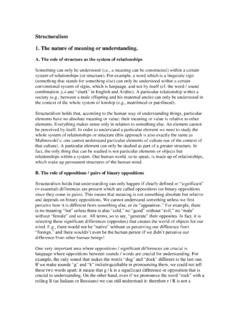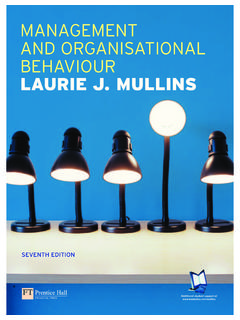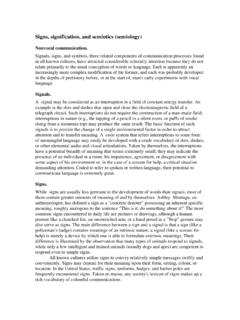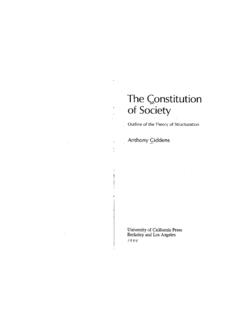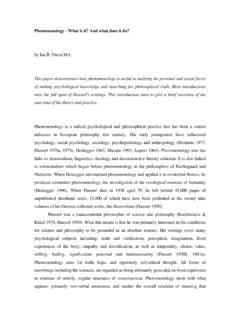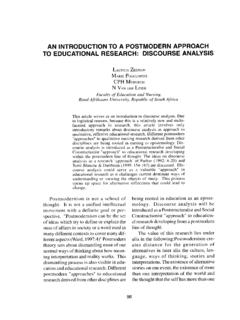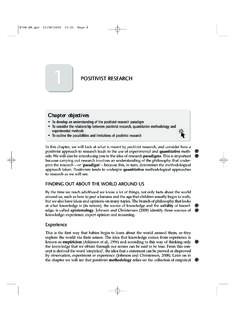Transcription of Modes of Constitutional Interpretation - fas.org
1 Modes of Constitutional Interpretation Brandon J. Murrill Legislative Attorney March 15, 2018. Congressional Research Service 7-5700. R45129. Modes of Constitutional Interpretation Summary When exercising its power to review the constitutionality of governmental action, the Supreme Court has relied on certain methods or Modes of Interpretation that is, ways of figuring out a particular meaning of a provision within the Constitution. This report broadly describes the most common Modes of Constitutional Interpretation ; discusses examples of Supreme Court decisions that demonstrate the application of these methods; and provides a general overview of the various arguments in support of, and in opposition to, the use of such methods of Constitutional Interpretation . Textualism. Textualism is a mode of Interpretation that focuses on the plain meaning of the text of a legal document.
2 Textualism usually emphasizes how the terms in the Constitution would be understood by people at the time they were ratified, as well as the context in which those terms appear. Textualists usually believe there is an objective meaning of the text, and they do not typically inquire into questions regarding the intent of the drafters, adopters, or ratifiers of the Constitution and its amendments when deriving meaning from the text. Original Meaning. Whereas textualist approaches to Constitutional Interpretation focus solely on the text of the document, originalist approaches consider the meaning of the Constitution as understood by at least some segment of the populace at the time of the Founding. Originalists generally agree that the Constitution's text had an objectively identifiable or public meaning at the time of the Founding that has not changed over time, and the task of judges and Justices (and other responsible interpreters) is to construct this original meaning.
3 Judicial Precedent. The most commonly cited source of Constitutional meaning is the Supreme Court's prior decisions on questions of Constitutional law. For most, if not all Justices, judicial precedent provides possible principles, rules, or standards to govern judicial decisions in future cases with arguably similar facts. Pragmatism. Pragmatist approaches often involve the Court weighing or balancing the probable practical consequences of one Interpretation of the Constitution against other interpretations. One flavor of pragmatism weighs the future costs and benefits of an Interpretation to society or the political branches, selecting the Interpretation that may lead to the perceived best outcome. Under another type of pragmatist approach, a court might consider the extent to which the judiciary could play a constructive role in deciding a question of Constitutional law.
4 Moral Reasoning. This approach argues that certain moral concepts or ideals underlie some terms in the text of the Constitution ( , equal protection or due process of law ), and that these concepts should inform judges' interpretations of the Constitution. National Identity (or Ethos ). Judicial reasoning occasionally relies on the concept of a national ethos, which draws upon the distinct character and values of the American national identity and the nation's institutions in order to elaborate on the Constitution's meaning. Structuralism. Another mode of Constitutional Interpretation draws inferences from the design of the Constitution: the relationships among the three branches of the federal government (commonly called separation of powers); the relationship between the federal and state governments (known as federalism); and the relationship between the government and the people.
5 Historical Practices. Prior decisions of the political branches, particularly their long-established, historical practices, are an important source of Constitutional meaning. Courts have viewed historical practices as a source of the Constitution's meaning in cases involving questions about the separation of powers, federalism, and individual rights, particularly when the text provides no clear answer. Congressional Research Service Modes of Constitutional Interpretation Contents Introduction .. 1. Textualism .. 5. Original Meaning .. 7. Judicial Precedent .. 10. Pragmatism .. 12. Moral Reasoning .. 15. National Identity or National Ethos .. 17. Structuralism .. 18. Historical Practices .. 22. Contacts Author Contact Information .. 25. Congressional Research Service Modes of Constitutional Interpretation Introduction Early in the history of the United States, the Supreme Court began to exercise the power that it is most closely and famously associated with its authority of judicial review.
6 In its 1803 decision in Marbury v. Madison,1 the Supreme Court famously asserted and explained the foundations of its power to review the constitutionality of federal governmental During the two decades following its holding in Marbury, the Court decided additional cases that helped to establish its power to review the constitutionality of state governmental If a challenged governmental action is unconstitutional, the Court may strike it down, rendering it When performing the function of judicial review,5 the Court must necessarily ascertain the meaning of a given provision within the Constitution, often for the first time, before applying its Interpretation of the Constitution to the particular governmental action under review. The need to determine the meaning of the Constitution through the use of methods of Constitutional Interpretation and, perhaps, construction,6 is apparent from the text of the document While several parts of the Constitution do not lend themselves to much debate about their preferred Interpretation ,8 much of the Constitution is broadly worded, leaving ample room for the Court to interpret its provisions before it applies them to particular legal and factual For example, the Second Amendment reads, A well regulated Militia, being necessary to the security of a free State, the right of the people to keep and bear Arms, shall not be infringed.
7 10 The text of the Amendment alone does not squarely resolve whether the right of the people to keep and bear arms extends to all citizens or merely is related to, or perhaps conditioned on, service in a militia. This ambiguity prompted a closely divided 2008 decision of the Supreme Court that ruled in favor of the former 1. 5 (1 Cranch) 137 (1803). 2. Id. at 180. 3. See, , Cohens v. Virginia, 19 (6 Wheat.) 264, 430 (1821); Martin v. Hunter's Lessee, 14 (1 Wheat.) 304, 362 (1816); Fletcher v. Peck, 10 (6 Cranch) 87, 139 (1810). 4. Id. The Court first struck down an action of the executive branch of the federal government as unconstitutional in Little v. Barreme, 6 (2 Cranch) 170, 177 79 (1804). The Court first struck down a state law as unconstitutional in Fletcher v. Peck. See 10 at 139. 5. The term judicial review refers to a court's power to review the actions of other branches or levels of government[, and especially] the courts' power to invalidate legislative and executive actions as being unconstitutional.
8 BLACK'S. LAW DICTIONARY 976 (10th ed. 2014). 6. Professor Keith Whittington has distinguished between the concepts of Constitutional Interpretation and Constitutional construction. In an influential book on the subject, he wrote that both Interpretation and construction of the Constitution seek to elaborate a meaning somehow already present in the text. However, Constitutional Interpretation relies on traditional legal tools that look to internal aspects of the Constitution ( , text and structure) to ascertain meaning, whereas Constitutional construction supplements the meaning derived from such traditional interpretive methods with materials outside of the text ( , moral principles or pragmatic considerations) where the text is so broad or so undetermined as to be incapable of faithful but exhaustive reduction to legal rules. KEITH. WHITTINGTON, Constitutional CONSTRUCTION: DIVIDED POWERS AND Constitutional MEANING 1, 5 7 (1999).
9 7. ERWIN CHEMERINSKY, Constitutional LAW 11 (4th ed. 2013). 8. For example, the Constitution provides a clear, bright-line rule that individuals who have not yet attained to the Age of thirty five Years are ineligible to be President. See CONST. art. II, 1, cl. 5. 9. Chemerinsky, supra note 7, at 11; CASS R. SUNSTEIN, THE PARTIAL CONSTITUTION 93 94 (1993). 10. CONST. amend. II. 11. See District of Columbia v. Heller, 554 570, 573 619, 635 36 (2008) (examining historical sources to determine the original meaning of the Second Amendment). Congressional Research Service 1. Modes of Constitutional Interpretation The text of the Constitution is also silent on many fundamental questions of Constitutional law, including questions that its drafters and those ratifying the document could not have foreseen or chose not to For example, the Fourth Amendment, ratified in 1791, does not on its face resolve whether the government may perform a search of the digital contents of a cell phone seized incident to arrest without obtaining a Thus, Interpretation is necessary to determine the meaning of ambiguous provisions of the Constitution or to answer fundamental questions left unaddressed by the drafters.
10 Some commentators have also noted the practical need for Constitutional Interpretation to provide principles, rules, or standards to govern future conduct of regulated parties, as well as political institutions, branches of government, and When deriving meaning from the text of the Constitution, the Supreme Court has relied on certain methods or Modes of Interpretation that is, ways of figuring out a particular meaning of a provision within the There is significant debate over which sources and methods of construction the Court should consult when interpreting the Constitution a controversy closely related to more general disputes about whether and how the Court should exercise the power of judicial review. Judicial review at the Supreme Court, by its very nature, can involve unelected judges16. overturning the will of a democratically elected branch of the federal government or popularly elected state officials.










